Bettendorf Wood Artist Sees Opportunity In Downed Trees
The 100-mile-per hour winds that pummeled the Quad-Cities on Aug. 10 produced more than power outages, downed trees and other property damage. The fast-moving, devastating derecho gave wood artist Steve Sinner of Bettendorf an opportunity.
The 78-year-old native of Omaha, Neb., is an internationally acclaimed woodturner and one of his latest projects is turning a chunk of a large tree trunk downed in Bettendorf, into a beautifully polished vessel.
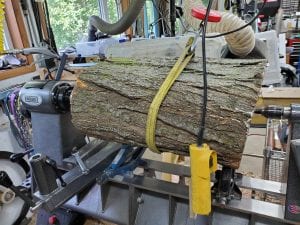
A tree trunk from the Aug. 10 derecho before its transformation.
Sinner found the hard maple trunk along Devils Glen Road, ideal for his use since the pieces he needs have to be as close to the center of the tree as possible.
“That pretty much means I have to have a vertical part of the tree, because if it’s a limb, the center will be way off and doesn’t work well for the sort of thing I do,” he said.
Woodturning is the process of fastening wood to a lathe that rotates around a centralized axis, allowing artists to use a series of chisels, gouges and other tools to carve away portions of the raw wood to create symmetrical forms. These vessels often have walls thinner than 1/8 inch, transforming rough blocks of wood into gleaming, elegant objects.
“When I turn stuff, it has to be wet, hollowed, and hung up to dry. Usually that takes anywhere from two to three weeks, to six or eight months,” Sinner said recently.
From the chunk of the trunk last month, it took two men to lift it. First, he mounted it on the lathe at his home studio, and turned it into a cylinder and hollowed out the middle. The bottom of the piece becomes the foot, which attaches to part of the lathe and the vessel is shaped as the wood spins. Sinner uses tools to cut away the wood as it spins.
The hollowing part takes longer, to remove parts of the wood, with a boring bar with a cutter on the end. Sinner uses a laser mounted to the bar, to determine the wall thickness, to make sure it’s consistent.
He hangs it upside down to try, so moisture doesn’t get caught inside. Once dry, it’s turned again, and works on the finishing process, with graphics or color, sanding, coating from two to 30 coats of finish. The process of doing the exterior could run three or four weeks.
“It just depends on what you’re doing and how complex it is,” Sinner said. The finished piece from this project is about 18 inches tall and 11 inches in diameter. He expects to finish it after drying in three months.
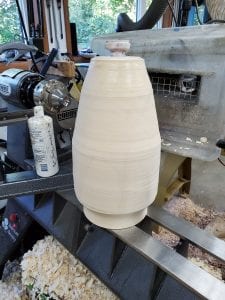
Sinner’s artwork in progress.
“I have an idea for what I want to do; that process will probably take me a week,” he said. “We’re air-drying wood, so the rule of thumb for drying wood is one year per inch of thickness.”
“You have a lot of pieces hanging. Now, I’d guess there are 40 pieces hanging in the studio now that are in the process of drying,” Sinner said.
“In the entire time I’ve been working wood, I purchased a tree one time,” he said. “That was a hard maple, that came from a woods near Donahue and Dixon, that’s a wooded area out there that’s primarily hard maple, very unusual.”
“It was a trunk that was more than 20 feet long, straight, so that was a lot of really good, centered wood to use.”
He’s so well-known for woodturning, that most of the time, friends or acquaintances will call him and offer a tree they had to take down.
“These days, I have more access to wood as a general rule than I have time to work on it. We did pick up in McClellan Heights, we did get some maple that was piled along the curb. I didn’t intentionally go driving around and looking for it. I just happened to see these as I went by them.”
Of the calls he gets from people, he goes to look at about 10 percent, and just 10 percent of those are usable.
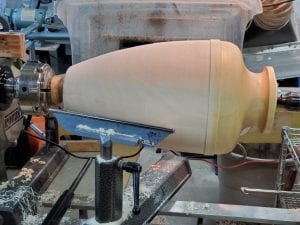
A vase being prepared.
“If you had a very large hard maple tree, when you cut it up, if you didn’t chip it, it would fill two or three dump trucks. Out of that entire tree, the wood that I would want would easily fit into my SUV.”
Sinner has produced many pieces for years that are auctioned in fundraisers for the Figge Art Museum and WQPT-TV, often netting thousands of dollars each.
“We are immensely grateful to Steve for donating a beautiful piece for our 15th anniversary auction,” Figge executive director Michelle Hargrave said Thursday of a rosewood vase that sold for $1,800.
“Steve has been an important partner over the years, and as part of the Figge’s strong commitment to artists from the region, we are proud to have shown his work in several exhibitions, all of which have been hugely popular with our audience,” she said.
“In addition to the donation, Steve also kindly offered a virtual tour of his studio during the 15 days of events we presented for our anniversary,” Hargrave said of last month’s celebration. “His generosity helped us to raise critical funding to offset loss of revenues due to Covid-19 and to ensure that we can continue to serve our community through dynamic exhibitions and programming.”
Focusing on four species
The four tree species Sinner is really interested in are walnut, sugar maple, hickory and cherry.
“Walnut stands out for its color and grain. It’s just a beautiful wood, so it makes a nice vessel all by itself; you don’t have to do much to it,” he said. “The hickory has a very open grain, in other words the grain is very coarse, so when you turn and sand it, there are some fairly hefty grooves. All wood has that; it’s pretty pronounced in hickory, so we can fill those grooves with color and cause some contrasts.”

Sinner’s artworks being created in his studio.
“Cherry is like walnut, a special wood as far as its appearance is concerned,” he said. Cherry has the additional advantage in, over the years it develops a beautiful patina,
“It’s beautiful to start with, but just gets prettier as it ages. As far as the hard maple is concerned, that’s what we like to use for a blank canvas to do a lot of artwork on. Those are the pieces that end up being the most time-consuming, the most difficult and the most expensive pieces.
“Hard maple is the most difficult to get, because it’s not a native tree around here,” Sinner said. “That’s one of the difficulties we have – most of the trees in town, which is most of the wood we get, they don’t grow straight and tall like they do in the woods. That’s one of the reasons there’s so little usable wood in them.”
He’s active in the Q-C chapter of the American Association of Woodturners, which is always on the lookout for downed trees. He said he didn’t get many calls after last month’s storm.
“I think the storm, it was kind a traumatic experience for a lot of folks and it wasn’t a matter of, I’m looking for an opportunity to make
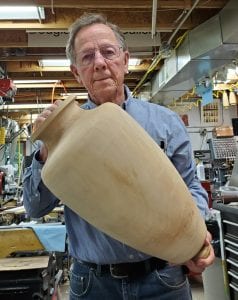
Steve Sinner, 78, holding the carved wood piece at his Bettendorf home studio.
something good out of this,” Sinner said. “Plus like most of us, they were left without power or Internet, no way to charge our phones and so on. It wasn’t the normal sort of a situation where you lose a tree.”
As for his own property – where he’s operated a work studio since 2001 – Sinner didn’t see much tree damage. He regained electricity after four and a half days, and was able to use a generator in the interim.
“I lost the top of a sweetgum tree in the backyard, but it’s not a huge loss because the tree was already in the process of dying. It’s been losing limbs for two, three years. I’ll probably have it cut down this fall anyway.”
Wood working for decades
Sinner’s early interest in woodworking led to a degree in Industrial Education from Iowa State University, followed by a 33-year career in industry and social services facilities management.
Woodworking first was a hobby, concentrating on furniture and clocks. In 1975, he read Dale Nish’s “Creative Woodturning,” which sparked what has become a passionate interest in artistic woodturning, according to Sinner’s bio. By 1998, he was turning full-time and in 2001, he and his wife Anne added a studio to their Bettendorf home.
Sinner concentrates on developing intricate surface decoration using silver leaf, acrylics and ink on deep hollow vessels turned primarily of maple, walnut or cherry.
His works are found in museums, galleries, and collections from New York to California and have been featured in art and craft publications in the United States, England and Australia.
The Cheongju International Craft Biennele in South Korea has exhibited his work three times and in 2003 awarded him a special citation. His work is in the permanent collections of four midwestern museums, the Cincinnati Art Museum, and the Museum of Arts and Design in New York City.
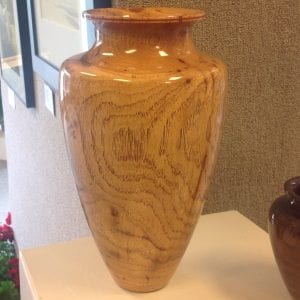
A pecan wood vase by Sinner and Meirhaeghe.
Sinner is included in the 2009 book “Masters: Woodturning: Major Works by Leading Artists.” Another book, “Wood Art Today 2,” published in 2010, features his newer ultra-thin ‘Spool’ series. The latest book to include his work is “Audacious: The Fine Art of Wood,” published in 2015.
His company, Advanced Lathe Tools, manufactures and sells the tools he developed over the years to create deep hollow vessels. He has taught and demonstrated in numerous art and craft schools, clubs, and symposiums for over 16 years.
“That business now requires, by far, the majority of my time,” Sinner said of Advanced Lathe Tools. “More so than I’d like. I don’t want to hire somebody, don’t want to contract out the work.”
He rarely works on commission; the pieces he does normally, averaging three or four per year, most go to charity – like the recent one he offered for auction for the Figge Art Museum’s 15th anniversary. Sinner typically donates a piece for WQPT’s annual fundraiser, Champagne on the Rocks.
For the Figge (for which he provides one vessel a year), the last one sold for $1,800, online, rather than a live auction. “It was a plain piece; I didn’t have any graphics of any kind on it,” Sinner said. “But it was made of rosewood, which is a beautiful wood, and it was purchased by a collector in Ohio.”
Most auctions, he sells pieces for $4,000 to $6,000, noting he really likes doing intricate designs.
Selling around the world
The most expensive piece Sinner sold was for $18,000 around 2006, a collaboration with Katie Kiley of Davenport, about a little town in Mexico, and the pattern was based on bricks in that town. She made eight detailed ink drawings around the piece from that town, on the Sea

A walnut wood vase by Sinner and Meiraeghe.
of Cortez.
Sinner was in New York City at the annual Sculptural Objects and Functional Art show, and met the collector from Los Angeles who liked his work. He bought Sinner’s piece sight unseen. “Katie’s drawings are extremely detailed and take a while to do,” he said.
“In 2008, the art market just died. A lot of galleries went out of business, including that Los Angeles gallery,” Sinner said. “That changed everything, really. Most of the work that I do now, I do as a collaboration with Joe Meirhaeghe of Orion, Ill.”
They sell pieces at the Figge gift shop, the Bereskin Gallery in Bettendorf, in Iowa City and Cedar Rapids.
“As a general rule, I usually put most of the exterior shapes on, and Joe does most of the hollowing,” Sinner said. “If I’m doing something else, he can do the exterior shapes. When it comes to the surface finishes, we’re both involved in those.”
In 2017, the American Association of Woodturners awarded them one of six excellence awards granted from a field of approximately 1,000 vessels displayed at their annual symposium. “That was for an innovative finish we had come up with,” Sinner said. “The rule is, to learn the rules then break them. That’s where the interesting, fun part comes in.”
Pat Bereskin, owner of the Bereskin Art Gallery, 2967 State St., Bettendorf, is very impressed with his work, which she’s shown for five years.
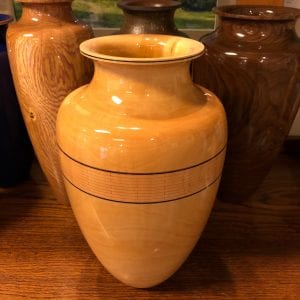
A maple vase by Sinner and Joe Meirhaeghe.
“The thing I love the most about what he does, he takes natural images that if he had harvested them any sooner, then it would be not the same piece that’s in existence today,” she said recently. “Every single rainstorm, every event in the life of the tree is reflected in the final illustration of the finished product. Hearing him talk about that, the different types of trees, is fascinating.”
“And the fact that it’s people from all corners of the world come here, to study with him, just elevates the man’s skills to master level,” Bereskin said. “He came in last summer, he had with him a student from Germany who came to study with him. It made me feel this student came to study, and we were the ambassadors for the arts in our community. He opens the door. It’s pretty cool.”
Sinner’s favorite part of the business is the friends he’s made, literally around the world.
“If I were to decide to go to New Zealand, if that were possible, I know three people in New Zealand who would insist that I stay with them,” he said. “I have friends all over – France, Italy, Germany, Israel, Greece, Canada and all over the United States.”
“This whole thing was an incredible trip,” he said in amazement. “For a kid that came from humble beginnings to get into the situation where – it’s hard to describe what happened. I’ve been to a party in a double penthouse at Grosvenor Square in Washington, D.C. – we were in
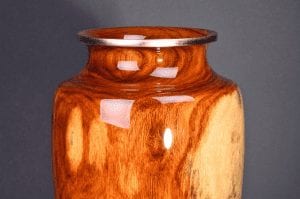
A view of the top half of the Florida rosewood vase sold last month at a Figge Art Museum auction.
jeans and being served by people in tuxedos. And I’ve been to a party on the coast of California, on a mountainside where the lady of the house served a 12-course meal outside over three hours.”
“There were years of that sort of thing, that were just unbelievable to me,” he said. “I got to go places and see things – not just pass through, but visit most of the major cities in the United States.”
In addition to woodturning, Steve plays bass clarinet in the Bettendorf Park Band and the Quad City Wind Ensemble, and was a nationally certified fire service instructor and volunteer firefighter for over 30 years.
Though he’s 78, Sinner shows no signs of slowing down, or resting on his bountiful laurels.
“I have to admit, the biggest boring bar I make is 50 pounds, and it’s getting to be a lot heavier than it used to be,” Sinner said of his woodturning equipment. “That happens, I guess it’s inevitable. But so far, I can manage it.”
To see some of his work available for sale, visit here.




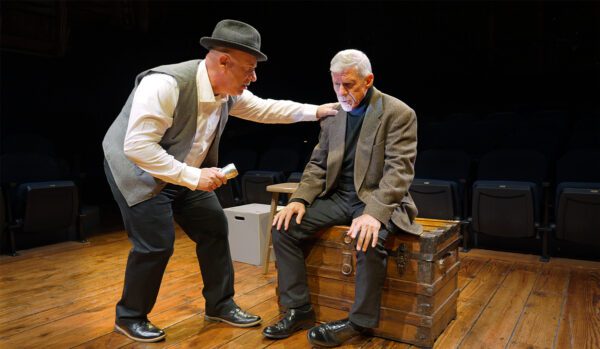
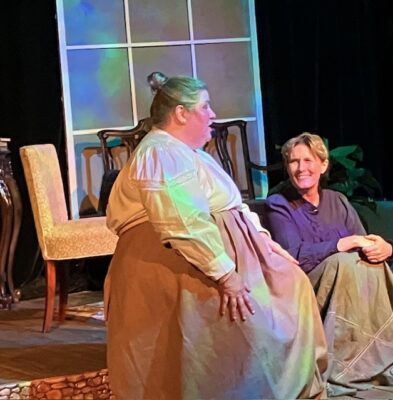







Leave a Reply
You must be logged in to post a comment.